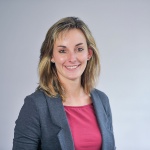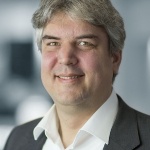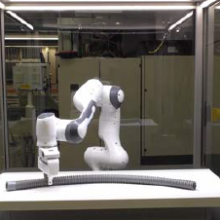The main aim of this focus area is on the automation concept of the robotic devices that interact with soft tissues. This interaction leads to completely new requirements that need to be fulfilled by the robots. Automating a new robot needs basic research on developing novel sensors, actuators, control systems and kinematic behaviour. Known automation concepts of robots for interaction with hard materials have to be evaluated, adapted and enhanced to suit new requirements. Reseach Area A and Reseach Area C will provide a better understanding of the static and dynamic behaviour of soft tissue and allows derivation of requirements for interaction. In addition, simulation models are directly integrated in the automation concept to improve the interaction process.
Research Projects @ University of Stuttgart
Goal of this project is to design and evaluate a distributed architecture for robot automation of handling deformable objects. It has to bridge the gap between high-throughput applications, as a physics simulation of a deformable object, and applications running with hard real-time requirements and cycle times in the lower milliseconds range. The architecture has to act as a middleware to connect single modules (as trajectory planning, robot and sensor integration, or parameter optimization) by establishing a communication between them and resolving dependencies between modules on initialization. (Supervisors: Dr Lechler, Prof. Verl, Prof. X. Xu)
Project S-9/I “Electro-mechanical Actuator Concepts for Robotic Applications” aimed at designing new types of electric drives, capable of delivering an improved torque behaviour for interaction with soft tissues in a light and compact package, suitable for industrial and medical robotics. The aspect of soft tissue robotics is as well a research topic in terms of software and control, as it is in hardware and actuation. Here, soft and hard actuation is typically considered, although soft actuators are mostly a highly interesting research topic, while the majority of industrial and medical robots uses hard actuators, because of reasons like higher torque density and often more simple torque control [*JT-1]. The aim of this project was, to design novel hard actuators, that have less problems acting soft and interacting with soft materials. This also included considerations of integrated concepts, regarding mechanical parts as a possible gearbox as well as electrical components such as the power electronics. Additionally, investigations into new types of materials and manufacturing methods were made, to further improve the possibilities of electrical robotic joint actuators. Finally, appropriate controllers were part of the overall design goals. (Supervisors: Prof. Parspour, A/Prof. McDaid)
The goal of my work is to extend existing works/methods in MPC to adequately address these challenges. In particular, the resulting design procedures should be practically applicable to solve dynamic problems for uncertain nonlinear systems. This problem can be decomposed into design of MPC framework for dynamic operation; and the design of MPC framework for robust/safe operation despite uncertainty. These methods should be mutually complementary to provide a general framework for robust trajectory tracking. Ideally, the practicality of the developed methods and concepts should be demonstrated in realistic simulations and/or experimental results. (Supervisors: Prof. Allgöwer, A/Prof. McDaid)
Research Projects @ University of Auckland
My PhD project involves the development and use of a model-based impedance load in order to determine the manner of which these pieces of muscle perform work. This load, based on a 3-element Windkessel model of vascular impedance, provides the muscle with a more realistic estimate of the contraction conditions the muscle experiences in the heart. Varying the model parameters allows for the performance of a range of work-loops representing different physiological loads, and allows for the prescription of both healthy and diseased loads to the muscle. I aim to utilise this model in order to compare its performance to other loading protocols and investigate its effect on muscle efficiency and the end-systolic zone in cardiac muscle. (Supervisors: Prof. Taberner, Dr. J.-C. Han, Prof. Allgöwer)
Systems that interact with soft bodies can face significant challenges. In the areas of agriculture (e. g. fruit harvesting, meat processing) and medical engineering, ill-defined, varying properties of objects and environment pose an obstacle for possible automation. A way to deal with the increased uncertainty is to use innovative sensors and actors. These sensors and actors produce varied and extensive amounts of data. A possible control system needs to provide increased computational resources and uncomplicated integration. Conventional control systems (often located next to the machine) lack these traits. We propose a new approach: individual components equipped with elementary computational resources, directly connected to an Ethernet-based network and able to communicate with each other. Through the network, computationally expensive tasks can be off-loaded to components in the cloud. The components, both hardware and software, of such system and control can be easily combined and re-arranged. (Supervisors: Prof. X. Xu, Dr. Y. Lu„ Dr Lechler)
In my project, I am trying to design and train an AI expert system to make the best possible decision for pruning, thinning, and harvesting, and providing accurate information for it is an essential step to achieve it. This information obtained from different sensors and cameras. We need to extract information and needed features such as length, diameter, and position of the objects, from these data. However, extracting accurate information from images is a challenge, especially when different elements affect on the data quality such as light, wind, etc. But the most difficult challenge is when other objects occlude some parts of the desired item. For example, while we are trying to detect each part of a cane accurately and tracking it until its end, we may face a situation that some part of it is occluded by one or more canes or any other object, and our algorithms need to estimate its features based on other details and information obtained from its neighbour. (Supervisors: Prof. MacDonald, Dr. H. Williams, Prof. Verl)
In this project, Project UoA-3/I, a novel mandibular motion-capturing system to record human subjects’ mandibular motion was developed and a chewing RAPR equipped by force sensors on its TMJs to measure the TMJs reaction forces while the RAPR is mimicking a human subject’s mandibular motion to chew a food material. First, a comprehensive literature review on RAPRs is presented. Then, the design of a novel, low-cost, and portable mandibular motion-capturing system is discussed and used for the first time in this study. The chewing RAPR mechanism is presented, and closed-form solutions for the RAPR’s kinematics and Jacobian analyses are investigated. Inverse dynamics of the RAPR is studied and two cost functions, corresponding to two neuromuscular objectives in human chewing, are formulated to solve the indeterminacy of the chewing RAPR’s inverse dynamics problem. Finally, disturbance observer-based control is used for trajectory tracking control of the RAPR’s mandible to follow a human subject’s mandibular motion captured by the motion-capturing system. (Supervisors: Prof. P. Xu, Dr. J. Dhupia„ Prof. Verl)
The objective of the project is to develop a control system for the soft surface table to sort multiple delicate objects without collisions. The theory is firstly planning the trajectory without collisions for each object, and then the soft surface table manipulate the objects tracking the pre-defined trajectory simultaneously. It is necessary to verify that the soft surface table is capable of manipulating object track the predefined trajectory. (Supervisors: Prof. P. Xu, Dr. J. Dhupia„ Dr Lechler)
Contact

Sina Schorndorfer
Coordinator GRK 2198
[Image: Universität Stuttgart]

Oliver Röhrle
Univ.-Prof.PI and Spokesperson GRK 2198
[Image: Universität Stuttgart]


